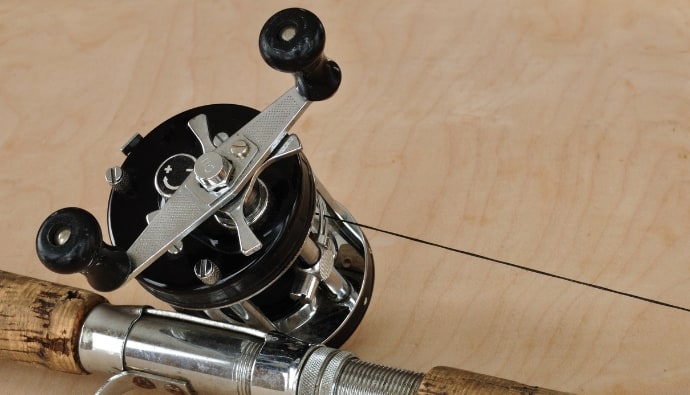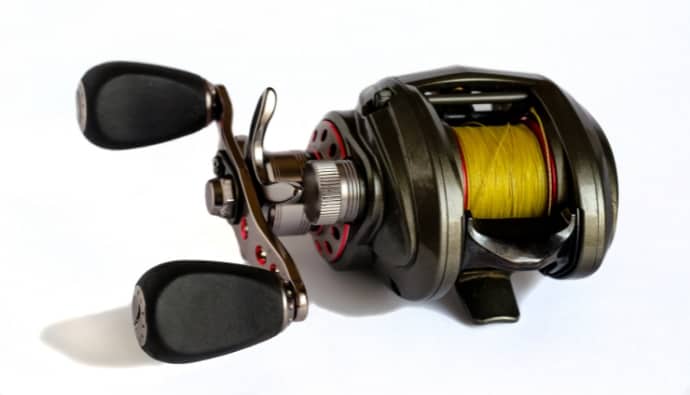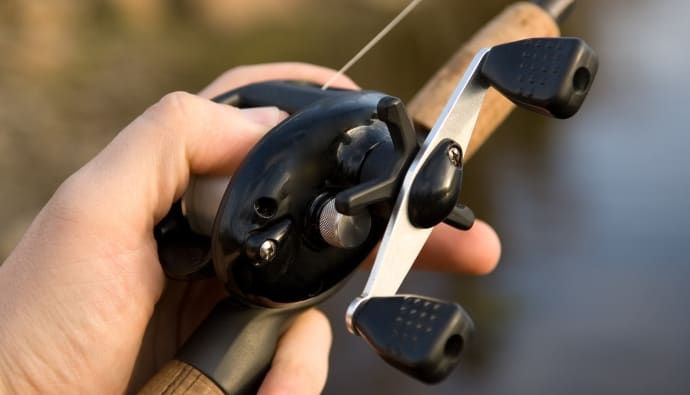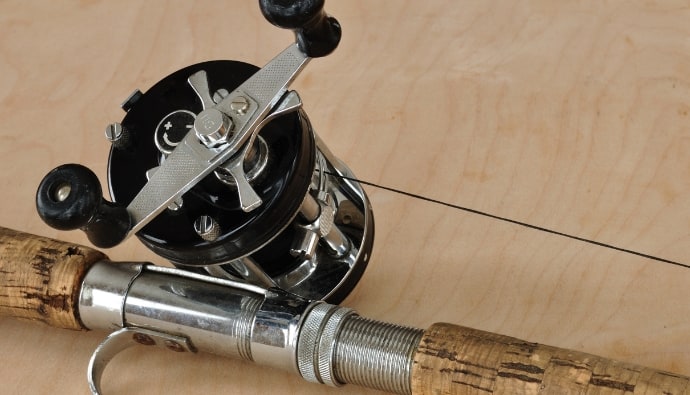The baitcasting reel’s gear ratio is the speed at which the line is retrieved when the handle is turned. Therefore, a higher gear ratio means the line is retrieved faster, while a lower gear ratio indicates that the line is retrieved slower. Higher gear ratios (anything above 6.3:1) help you to retrieve your lures quickly, while low gear ratios (4.9:1 and below) allow you to retrieve your lure at a steady pace and are ideal when using live bait.
Several things determine the correct gear ratio, including the size and weight of your lures, personal preference, and preferred fishing type. This article will review in detail how gear ratio affects your fishing. Let’s get started.

How Gear Ratio Affects Retrieve Speed
A gear ratio relates to the number of times the spool rotates for each turn of the handle, which affects how fast you can reel in your line. For example, a ratio of 6.4:1 means the spool rotates 6.4 times for every time the handle is rotated. This is called the “6.4:1 gear ratio” or “6.4:1 speed.”
A baitcasting reel with a higher gear ratio rotates faster than one with a lower ratio. This means you need to use different baits and techniques when fishing with high-gear reels than you would with one with a lower gear setup.
The Relationship Between Gear Ratio and Retrieve Speed
The baitcaster gear ratio determines the speed at which it retrieves a cast line. A high ratio means you draw in your line quickly, while a lower ratio results in a slower retrieval speed.
Suppose you had two casting reels with a ratio of 6:1 and 7.5:1, respectively. This implies that if you use 60 feet of line on both, the high-speed reel will retrieve the line faster than the 6:1 gear ratio. However, one must consider factors that affect the retrieve process, such as the size of the spool, the drag system, and the power of the retrieve.
The baitcaster gear ratio that’s right for you depends on your target fish. A fast gear ratio is ideal for bass fishing using Carolina rigs, while a lower ratio is best for big baits that pull a lot. However, one must consider factors such as spool size, the drag system, and the power of the retrieve.
The Benefits of a High Gear Ratio
There are several benefits to using a higher-ratio fishing reel:
- Faster retrieve: High-speed baitcasters allow anglers to retrieve their line more quickly, which can be especially useful when trying to reel in large or fast-moving fish.
- Better control over fish: A high-speed reel allows bass anglers to have more control over the retrieve speed. They can exert more control over the fish by applying more pressure to the line to slow down the retrieve and tire it out or speed it up to pull the fish in more quickly.
- More power: High ratio setups provide more mechanical advantage, which means you can apply more force to the fish. This is helpful when trying to keep a large or strong fish in the strike zone.
- Greater casting distance: High-speed casting reels provide more power to drive the spool during casting, which increases the distance of a cast.
- More sensitivity: High-speed reels offer greater sensitivity when fighting with fish. This enables anglers to detect subtle bites and changes in the fish’s movements.
- Better hook setting: High gear ratios help set the hook more quickly and firmly due to how the spool is positioned and how the line is released from the spool. This enhances the chances of landing more fish.
- Less fatigue: Unlike spinning reels, high-speed fishing reels retrieve the line more quickly with less effort. This is helpful when fishing for long periods as it minimizes fatigue while improving fishing efficiency.
The Benefits of a Medium Gear Ratio
The benefits of a medium gear ratio in a fishing reel include the following:
- Greater versatility: Medium gear baitcasting reels provide a balance between the fast retrieve speed of high gear ratios and the slow retrieve speed of low gear ratios, making them the best gear ratio choice for many different fishing situations and species.
- Smoother retrieve: A medium gear rig allows anglers to retrieve their line at a moderate speed, which can be more comfortable and less tiring than reeling in quickly with high-speed reels.
- Longer casts: Medium gear reels provide enough power for decent casting distance while still allowing for a slower retrieve.
- Better casting control: Medium gear rods provide more control over the cast, which is especially useful when casting in windy conditions or tight spaces.
- Greater line capacity: Most medium-gear rigs have larger spools that hold more lines than high-gear ratio reels. This is advantageous for many anglers who need longer casts.
- Better control over drag: A medium gear ratio allows anglers to have better control over the resistance on the line as the fish pulls it out. This is especially useful when fighting larger or stronger fish.
Note: Medium rods are the best gear ratio for beginner anglers or those looking for a versatile reel that can be used in various fishing situations. However, these reels aren’t the best choice for fast or strong fish, as they may not retrieve the line quickly enough to keep up with the fish’s movements.
The Benefits of a Low Gear Ratio
The benefits of a low gear ratio in a fishing reel include the following:
- More power: Low-gear rigs provide more torque and power, which can be beneficial when fighting large or strong fish.
- Greater control over the fight: Low-gear reels allow anglers to exert more control over the fish by reeling in slowly and applying more pressure to the line. This is beneficial when trying to tire out the fish or using specific techniques, such as deep-sea fishing.
- High line capacity: Lower gear rods typically come with larger spools that hold more fishing lines. This is the best ratio for catching fish using heavy or long casts.
- Better for fishing in deep water: Low gear ratios are better for catching fish in deep water as they retrieve the line slower. They are well suited for techniques such as trolling, and jigging, where more power is needed to pull the fish out of cover and keep the bait or lure in the strike zone longer.
Note: Because low-gear models tend to be less efficient at retrieving the line than high or medium-gear ratios, it results in more fatigue for the angler.
Choosing the Right Gear Ratio for Different Fishing Situations
When it comes to baitcaster gear ratios, there’s no one-size-fits-all answer. When selecting a gear ratio for a fishing reel, consider factors such as:
Type of Fish
Different fish species have different swimming speeds and strengths: some are fast and strong, and others are slow and weak. A high-ratio reel is well suited for fast fish, while a slower reel is better for strong fish. A medium gear ratio is versatile and can be used for various fish.
Type of Lure
Different lures have varying weights and drag characteristics. A high gear ratio is well suited for fast-moving lures, while a lower gear ratio is better for heavy or slow-moving lures.
Fishing Technique
Different fishing techniques require different retrieve speeds and power. For instance, casting heavy lures and trolling calls for a slower speed for more power, while casting long-distance and fast retrieves requires high speeds for greater distance.
Fishing Environment
A higher baitcaster gear ratio is appropriate for saltwater fishing because of the strong currents, while freshwater fishing can be done with a medium or low ratio.
Personal Preference
The angler’s personal preference and level of experience. Some opt for the added power and control of low gear reels, while others prefer the high speed and sensitivity of fast reels.
Examples of Gear Ratios and Their Recommended Uses
Some common settings include:
- 7.1:1 to 9.0:1: These baitcasting reels are best suited for very fast retrieves in freshwater or saltwater environments where the fish are active and fast-moving, such as casting big swimbaits or trolling for tuna. A fast reel is ideal when using weighted lures, covering a lot of water quickly, making long casts, fishing in open water, or in situations where a high-speed retrieve is necessary to hold the bait in the strike zone.
- 6.4:1: This is the most common reel speed, as it allows for fast retrieves. It’s the best gear ratio for catching fast-moving fish like bass or making long casts with heavy baits.
- 5.0:1 to 5.4:1: These reel options generate high torque to support big baits that pull a lot. The lower reel is appropriate for slow-moving baits or fishing in heavy cover, as they provide more power for pulling more fish out of dense vegetation.
- Some high-speed baitcasters can have gear ratios of up to 10.1:1. This speed reel is suited for fast-paced fishing tactics in freshwater or saltwater, such as burning a spinner bait or deep diving crankbaits. These baitcaster gear ratios make quick retrieves on topwater lures and are handy for targeting fast fish like tuna and wahoo.
Adjusting the Gear Ratio on a Baitcasting Reel
Adjusting the gear ratio on baitcast reels involves changing the relationship between the spool and the handle. The first step is to decide the optimal gear ratio for your specific fishing situation by considering factors such as lure size and weight, water conditions, and target species.
The actual adjustments are achieved by either:
- Loosening the side plate and adjusting the spool tension
- Adjusting the position of the spool on the reel’s shaft
- Turning a small knob or lever on the side of the reel, or
- Removing the side cover and adjusting the gears directly
Adjustments increase or decrease the gear ratio, which determines the speed at which the line is retrieved. However, changing these settings affects the reel’s casting distance and accuracy, so it’s important to experiment with different settings to find the one that works best for your fishing situation.
Note: The gear ratio of a baitcasting reel is usually set at the factory and should only be adjusted by experienced anglers who understand the mechanics of your reel type and the effects of different ratios on casting and retrieving.
Tips for Adjusting the Gear Ratio for Optimal Performance
Here are a few tips to help you when adjusting the gear ratio for optimal performance on a baitcasting reel:
- Follow the manufacturer’s recommendations: Before making any adjustments, consult the manufacturer’s instructions for recommended gear ratios for different fishing applications. This gives you a starting point for adjusting the gear ratio.
- Experiment with different ratios to find a baitcaster reel that works best for your fishing technique and your fishing conditions. The best gear ratio for one technique may be unfit for another.
- Consider the weight of your lure or bait as you adjust the gear ratio: A heavier lure or bait works best with lower gear ratios for a slower retrieve, while lighter versions require a high ratio reel for a faster retrieve.
- Account for the size and power of the fish you are targeting: A higher gear ratio will provide more power and a faster retrieve. The speed helps when reeling in larger and more powerful fish.
- Pay attention to the backlash: If you are experiencing backlash, it may be caused by the gear ratio being too high. Try reducing it to see if this helps reduce backlash.
- Check the drag system, too: An optimal drag system minimizes bird nesting and helps when fighting big fish.
- Clean and maintain regularly: Regular maintenance keeps your reels functioning smoothly and prevents wear and tear.
Conclusion
Gear ratios determine how quickly you can retrieve the line, so it’s important to pick a gear ratio that is a good fit based on your fishing preferences and style. A low ratio offers more torque and better control when fighting fish, while a high-gear rod is handy when you’re after precision during long-distance casts.
If you have any questions about what features you need in a reel, it’s best to consult with an experienced angler who knows their stuff. And don’t be afraid to experiment with different reel arsenal until you find the one that works best for you and your fishing style.




 Facebook
Facebook YouTube
YouTube







